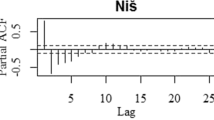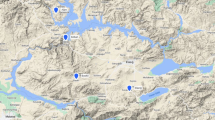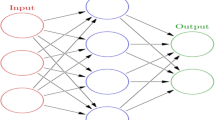Abstract
The use of artificial neural networks (ANNs) in estimation of evapotranspiration has received enormous interest in the present decade. Several methodologies have been reported in the literature to realize the ANN modeling of evapotranspiration process. The present review discusses these methodologies including ANN architecture development, selection of training algorithm, and performance criteria. The paper also discusses the future research needs in ANN modeling of evapotranspiration to establish this methodology as an alternative to the existing methods of evapotranspiration estimation.



Similar content being viewed by others
References
ASCE Task Committee on Application of Neural Networks in Hydrology (2000a) Artificial neural network in hydrology. I: preliminary concepts. J Hydrol Eng ASCE 5(2):115–123
ASCE Task Committee on Application of Neural Networks in Hydrology (2000b) Artificial neural network in hydrology. II: hydrologic application. J Hydrol Eng ASCE 5(2):124–137
Berry MJA, Linoff G (1997) Data mining techniques. Wiley, NY
Bruton JM, McClendon RW, Hoogenboom G (2000) Estimating daily pan evaporation with artificial neural networks. Trans ASAE 43(2):491–496
Campolo M, Andreussi P, Sodalt A (1999) River stage forecasting with a neural network model. Water Res Res 35(4):1191–1197
Cigizoglu HK (2003) Estimation, forecasting and extrapolation of flow data by artificial neural networks. Hydro Sci J 48(3):349–361
Cochran WG, Cox GM (1957) Experimental designs, 2nd edn. Wiley, New York
Dai X, Shi H, Li Y, Ouyang Z, Huo Z (2009) Artificial neural network models for estimating regional reference evapotranspiration based on climate factors. Hydrol Process 23(2009):442–450
Dawson WC, Wilby R (1998) An artificial neural networks approach to rainfall-runoff modeling. Hydrol Sci J 43(1):47–66
French MN, Krajewski WF, Cuykendall RR (1992) Rainfall forecasting in space and time using a neural network. J Hydrol 137:1–31
Gomez KA, Gomez AA (1984) Statistical procedures in agricultural research, 2nd edn. Wiley, New York
Hargreaves GH, Samani ZA (1985) Reference crop evapotranspiration from temperature. Appl Eng Agric 1(2):96–99
Hegazy T, Ayed A (1998) Neural network model for parametric cost estimation of highway projects. J Constr Eng Manag ASCE 124(3):210–218
Jain SK, Nayak PC, Sudhir KP (2008) Models for estimating evapotranspiration using artificial neural networks, and their physical interpretation. Hydrol Process 22(13):2225–2234
Jensen ME, Burman RD, Allen RG (1990) Evapotranspiration and Irrigation Water Requirements. ASCE Manual and Rep. on Engrg. Pract. No. 70. ASCE, New York
Jones JW, Ritchie JT (1990) Crop growth models. In: Hoffman GJ, Howel TA, Solomon KH (eds) Management of farm irrigation systems. ASAE Monograph no. 9, ASAE, St. Joseph, MI, USA, pp 63–89
Keskin ME, Terzi O (2006) Artificial neural network models of daily pan evaporation. J Hydrol Eng 11(1):65–70
Khoob AR (2008a) Comparative study of Hargreaves’s and artificial neural network’s methodologies in estimating reference evapotranspiration in a semiarid environment. Irrig Sci 26(3):253–259
Khoob AR (2008b) Artificial neural network estimation of reference evapotranspiration from pan evaporation in a semi-arid environment. Irrig Sci 27(1):35–39
Kim S, Kim HS (2008) Neural networks and genetic algorithm approach for nonlinear evaporation and evapotranspiration modeling. J Hydrol 351:299–317
Kisi O (2006) Generalized regression neural networks for evapotranspiration modeling. Hydrol Sci J 51(6):1092–1105
Kisi O (2007) Evapotranspiration modeling from climatic data using a neural computing technique. Hydrol Process 21(14):1925–1934
Kisi O (2008) The potential of different ANN techniques in evapotranspiration modeling. Hydrol Process 22:2449–2460
Kisi O (2009) Daily pan evaporation modelling using multi-layer perceptrons and radial basis neural networks. Hydrol Process 23:213–223
Kisi O (2010) Fuzzy genetic approach for modeling reference evapotranspiration. J Irrig Drain Eng 136(3):175–183
Kisi O, Cimen M (2009) Evapotranspiration modeling using support vector machine. Hydrol Sci J 54(5):918–928
Kisi O, Ozturk O (2007) Adaptive neuro-fuzzy computing technique for evapotranspiration modeling. ASCE J Irrig Drain Eng 133(4):368–379
Kumar M, Raghuwanshi NS, Singh R, Wallender WW, Pruitt WO (2002) Estimating evapotranspiration using artificial neural network. J Irrig Drain Eng ASCE 128(4):224–233
Kumar M, Bandyopadhyay A, Rahguwanshi NS, Singh R (2008) Comparative study of conventional and artificial neural network-based ETo estimation models. Irrig Sci 26(6):531–545
Kumar M, Raghuwanshi NS, Singh R (2009) Development and validation of GANN model for evapotranspiration estimation. J Hydrol Eng ASCE 44(2):131–140
Landeras G, Ortiz-Barredo A, Lopez JJ (2008) Comparison of artificial neural network models and empirical and semi-empirical equations for daily reference evapotranspiration estimation in the basque country (Northern Spain). Agric Water Manag 95(5):553–565
LeCun Y, Boser B, Denker JS, Henderson D, Howard RE, Hubbard W, Jackel LD (1989) Backpropagation applied to handwritten ZIP code recognition. Neural Comput 1:541–551
LeCun Y, Simard PY, Pearlmetter B (1993) Automatic Learning Rate Maximization by On-Line Estimation of the Hessian’s Eigenvectors. In: Hanson SJ, Cowan JD, Giles CL (eds) Advances in neural information processing systems 5. Morgan Kaufmann, San Mateo, CA, pp 156–163
Maier HR, Dandy GC (2000) Neural networks for the prediction and forecasting of water resources variables: a review of modeling issues and application. Environ Model Softw 15:101–124
Markham IS, Rakes TR (1998) The effect of sample size and variability of data on the comparative performance of artificial neural networks and regression. Comput Ops Res 25(4):251–263
Marti P, Royuela A, Manzano J, Palau-Salvador G (2010) Generalization of ETo ANN models through data supplanting. J Irrig Drain Eng 136(3):161–174
Moghaddamnia A, Gousheh MG, Piri J, Amin S, Han D (2009) Evaporation estimation using artificial neural networks and adaptive neuro-fuzzy inference system techniques. Adv Water Res 32:88–97
Monteith JL (1965) Evaporation and Environment. Proceedings of the state and movement of water in living organisms. XIXth Symposium, Soc. For Exp. Biol. Swansea, Cambridge University Press, New York, pp 205–234
Odhiambo LO, Yoder RE, Yoder DC, Hines JW (2001) Optimization of fuzzy evapotranspiration model through neural training with input-output examples. Trans ASAE 44(6):1625–1633
Orr GB, Leen TK (1997) Using Curvature Information for Fast Stochastic Search. In: Mozer MC, Jordan MI, Petsche T (eds) Advances in neural information processing systems 9. The MIT Press, Cambridge, pp 606–612
Parsuraman K, Elshorbgy A, Carey SK (2007) Modelling the dynamics of the evapotranspiration process using genetic programming. Hydro Sci 52(3):563–578
Penman HL (1948) Natural evaporation from open water, bare soil and grass. Proc R Soc Lond 193:120–146
Rao V, Rao H (1996) C++ neural networks and fuzzy logic. BPB Publications, B-14, Connaught Place, New Delhi-110001, pp 380–381
Rumelhart RE, Hinton GE, Williams RJ (1986) Learning internal representations by error propagation. Parallel distributed processing, vol Vol 1. MIT Press, Cambridge, pp 318–362
SNNS (1995) User manual, version 4.1, report no. 6/95. Institute for Parallel and Distributed High Performance Systems. University of Stuttgart, Germany
Snyder R, Pruitt W (1985) Estimating reference evapotranspiration with hourly data, Chap. VII. In: R. Snyder et al. (eds) California irrigation management information system final report. University of California-Davis. Land, Air and Water Resources Paper no. 10013, California, USA
Sudheer KP, Gosain AK, Rangan M, Saheb SM (2002) Modelling evaporation using an artificial neural network algorithm. Hydrol Process 16:3189–3202
Sudheer KP, Gosain AK, Ramasastri KS (2003) Estimating actual evapotranspiration from limited data using neural computing technique. J Irrig Drain Eng ASCE 129(3):214–218
Swingler K (1996) Applying neural networks: a practical guide. Academic Press, London
Trajkovic S (2005) Temperature-based approaches for estimating reference evapotranspiration. J Irrig Drain Eng ASCE 131(4):316–323
Trajkovic S (2009) Comparison of radial basis function networks and empirical equations for converting from pan evaporation to reference evapotranspiration. Hydrol Process 23(2009):874–880
Trajkovic S, Stankovic M, Todorovic B (2000) Estimation of FAO Blaney–Criddle b factor by RBF network. J Irrig Drain Eng ASCE 126(4):268–270
Trajkovic S, Todorovic B, Stankovic M (2003) Forecasting reference evapotranspiration by artificial neural networks. J Irrig Drain Eng ASCE 129(6):454–457
Traore S, Wang Y, Kerh T (2010) Artificial neural network for modeling reference evapotranspiration complex process in Sudano-Sahelian Zone. Agric Water Manage 97:707–714
Yeh IC (1998) Quantity estimation of building with logarithm-neuron networks. J Constr Eng Manage ASCE 124(5):210–218
Zanetti SS, Sousa EF, Oliveira VPS, Almeida FT, Bernardo S (2007) Estimating evapotranspiration using artificial neural network and minimum climatological data. J Irrig Drain Eng 133(2):83–89
Author information
Authors and Affiliations
Corresponding author
Additional information
Communicated by S. Raine.
Rights and permissions
About this article
Cite this article
Kumar, M., Raghuwanshi, N.S. & Singh, R. Artificial neural networks approach in evapotranspiration modeling: a review. Irrig Sci 29, 11–25 (2011). https://doi.org/10.1007/s00271-010-0230-8
Received:
Accepted:
Published:
Issue Date:
DOI: https://doi.org/10.1007/s00271-010-0230-8




